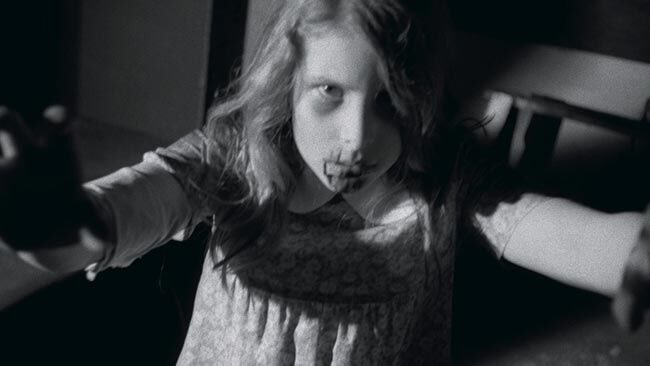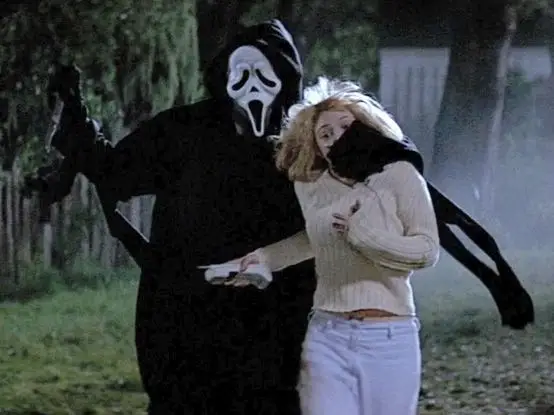What’s your favorite part of seeing a horror movie? If you’re anything like me – and if you are, I’m truly sorry – then the only possible answer is “the kills.” Stabbings, drownings, decapitations, slashings… whatever form they take, kills are often the most memorable part of a horror movie. In this list, I will document ten of the most iconic and influential kills in the history of horror. Let’s get started. (Spoilers ahead!)
10. Night of the Living Dead — Mommy Dea(d)est.

George Romero’s 1968 masterpiece is one of the most influential horror movies ever made. Borrowing from both Caribbean folklore and the works of Richard Matheson, Night of the Living Dead single-handedly invented the zombie movie as we know it. Its black and white photography and over-the-top acting may betray its 60s origins, but the brutality and nihilism of the film have not aged a day.
Although its sequels would up the gore factor, neither of them contain a kill as effective as the one at the climax of Night. In the most blood-curdling scene of the movie, a zombified girl mercilessly hacks her mother to death with a trowel
before chowing down on her corpse. The sound mixing and editing in this scene elevate it into a nightmarish fever dream. Most chilling of all, though, is the scene’s symbolic significance. In a world in which sweet young girls kill and eat their own mothers, truly nothing is sacred.
9. Scream — What’s Your Favorite Scary Movie?

By the mid-90s, horror had become exhausted. A deluge of unimaginative slashers and never ending sequels had turned the genre into a punchline. Wes Craven’s Scream couldn’t have come at a better time. Hilariously skewering slasher tropes, Scream also stands alone as one of the best horror movies of the decade.
And what is a great slasher without a great first kill? Scream’s is certainly one for the books, taking the controversial choice to kill star Drew Barrymore before the opening credits even roll. The scene is a masterclass in tension and terror. What begins as a playful phone conversation about scary movies escalates into the quiz show from hell, culminating in a chase that introduces the now-iconic Ghostface. When the victim’s parents discover her mutilated corpse, guts hanging out, you know you’re in for a grisly ride.
8. The Texas Chainsaw Massacre – Hammer Time.

Tobe Hooper scares me. Yes, I know we’re supposed to separate the artist from the art. But anyone who could make a movie as grimy, disturbing, and punishing as loosely based on a true story The Texas Chainsaw Massacre has to have a few screws loose, right? Sadly, Mr. Hooper passed away in 2017. The uncompromising horror of Texas Chainsaw, however, will live forever.
Ironically, the most iconic kill in the original Texas Chainsaw Massacre doesn’t involve a chainsaw at all. Instead, Leatherface dispatches his first victim with a short, sharp blow with a hammer. The sound design and editing of the scene are brilliant for their simplicity – it is easy to forget that no real gore is shown. But it is the nonchalance of the action that really raises the terror factor; you get the impression that Leatherface does this sort of thing every day, seeing human beings as nothing more than a potential next meal.
7. Hereditary – Don’t Lose Your Head!

The most recent entry on this list is also the one that quite possibly traumatized me the most. In the few short years since its release, Ari Aster’s Hereditary has earned a fearsome reputation for grueling and unflinching horror. Ask any horror fan what the scariest movie they’ve seen recently is, and there’s a good chance Hereditary will be the answer.
Does it count as a kill if the “killer” is a telephone pole? No matter: the sudden and shocking decapitation of Charlie in Hereditary is the most harrowing death scene I have seen in years. The moment of death is effective enough, but it is the scenes that come after which really push the horror to unflinching extremes. The image of Peter lying awake all night, after he knows what he has done… the parents’ screams in the morning… the slam cut to the severed head covered in ants… I’m shivering just writing about it now.
6. Nightmare on Elm Street – Depp Red

Halloween and Friday the 13th may have laid the foundation for the slasher subgenre, but Nightmare on Elm Street is arguably more iconic than both franchises. This is due, of course, to the incomparable Freddie Kreuger, the most charismatic and creative figure in the whole slasher villain pantheon.
This kill from the first Nightmare is a classic example of Freddie’s style: gory, over-the-top, and darkly hilarious. As our heroine Nancy hopelessly attempts to warn him, Glen (Johnny Depp!) is dragged into his mattress and transformed into a literal blood tornado. It’s one of the most memorable moments from the original film, and serves as a perfect calling card for the one and only Freddie Kreuger.
5. Alien – Getting Something Off My Chest.

Is Ridley Scott’s Alien a horror movie, or just science fiction? Who cares? It remains one of the scariest and influential movies of the 1980s, regardless of the genre labels you throw on it. But even if it contained nothing more exciting than the kill I’ve highlighted here, it would be an unforgettable film.
Obviously I’m talking about the chestburster scene, one of the most gruesome kills ever put on film. As the crew of the starship Nostromo is enjoying a meal following a close encounter with some overly affectionate aliens, John Hurt doubles over and clutches his chest in pain. The next few moments are a blur of blood and guts that should be enough to put anyone off their meal. Some of the film’s following scenes may be more claustrophobic and violent, but none are as viscerally horrifying.
4. The Omen – Look At Me, Damien!

The Omen was sort of the Hereditary of its day: a classy film, featuring respectable actors and directors, that nevertheless plumbed the depths of modern American horror. Dealing with blasphemy, bestiality, and infanticide (among other nasty topics,) it is honestly a little shocking that The Omen was so popular with contemporary audiences.
It was hard to pick just one kill from this movie, as there are several memorable ones. Honorable mention is reserved for the encounter between photographer Keith and a pane of glass, but the real prize goes to the sucide of five-year-old Antichrist Damien’s nanny. Announcing in a ghoulishly cheerful voice that she
is doing it “all for you!,” the nanny hangs herself from a high window in front of a crowd of children. Forget the end times – the therapy bills for those kids will be the real horror story.
3. Halloween – Sibling Rivalry.

When John Carpenter was tasked with making a film about some babysitters getting murdered, there was no way he could have known what he was starting. Cut to just a few years later, and the slasher would become the defining subgenre of horror, earning equal parts applause and criticism. It’s hard to believe it all started with a movie as simple – and as well executed – as John Carpenter’s Halloween.
The slasher is one of the most formulaic of horror subgenres, and nearly all of them start with a flashback to the killer’s childhood. In this case, the audience peers through the eyes of young Michael Myersas he murders his sister with a
butcher knife. Although not as bloody as later slashers would become, the use of POV, the sound design, and the iconic score make this kill effective to this day. Michael Myers would go on to slaughter dozens of teens, but his first kill will always remain the most memorable.
2. Jaws – Don’t Get In The Water!

Jaws changed everything. Considered the first true blockbuster, this summer chiller by a little director named Steven Spielberg didn’t just make audiences scared to go into the water; it drew them to the theaters in droves, forever transforming the way Hollywood made and sold movies.
When it comes to the kills in Jaws, nothing can beat the horror of the first five minutes, in which a tipsy, reckless co-ed decides to go out for a nighttime skinny dip. While such shenanigans are inadvisable in a horror movie setting, can you really blame young Chrissie for thinking the water was safe? As John Williams’ ominous score picks up in volume, the audience can only watch in terror as she is dragged to her watery fate. It’s not the bloodiest kill of 70s horror, but it may well be the most important in the long run.
1. Psycho – Showertime.

While it did not exactly follow the formula that would be cemented by Halloween, Psycho remains the great-granddaddy of all slasher movies to come. Michael Myers, Ghostface, Leatherface, and more would never have slit a single throat if Norman Bates hadn’t first slipped into his mother’s dress and paid an unsuspecting visit to poor Marion Crane.
Of course I’m talking about the shower scene. What list of horror movie kills would be complete without it? Whole books have been written on this iconic scene, and the ways that it uses editing, music, and performance to capture sheer horror. While it is hard for modern audiences to appreciate just how shocking this scene was, its importance cannot be understated. Every other kill on this list owes its existence to the shower scene – one could even argue that the entire genre of modern horror was born in these three minutes.

Joseph Green is a writer, filmmaker, and lifelong horror nut. When he isn’t watching horror movies or listening to heavy metal music, he is writing articles about them.
